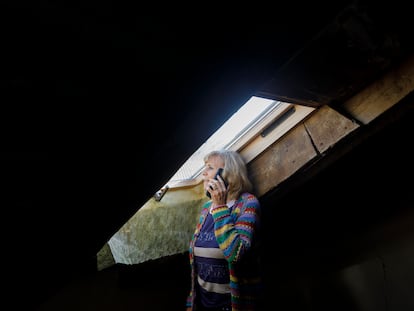The digital gender gap, a major obstacle to the fight for equality for women in Pakistan
Only 26% of Pakistani women have access to the internet, compared to 47% of men, one of the most pronounced digital gender gaps in the world. The lack of access to the Internet makes it more difficult for them to educate themselves, progress at work and fight cyberbullying

“A young woman who was my distant cousin was killed by her uncle because she was allegedly texting a ghair mard (a man who wasn’t her relative). The police buried the case. There were no hashtags, no news, no advocacy for justice. Maybe if we did have access to online spaces, there would’ve been more outrage,” says 20 year old Maryam Jamali, who runs Madat Balochistan, an organization working for development in Balochistan and Sindh, in the south of Pakistan.
Amna, a 25 year old who works as a nanny in Lahore says there’s only one mobile phone at home, which she can only use in front of her father. It makes it difficult for her to contact her employer or even try and educate herself through online materials. She’s had friends take online courses to get better jobs but because of her limited access can’t do the same for herself.
These are just two examples of how the digital divide is holding back women in Pakistan. In this country, the fifth most populous in the world (with 220 million inhabitants), half of the population has some form of internet access, according to the NGO Bytes For All, but it is one of the nations with the most pronounced digital gender gap on the planet, with 26% of women having internet access, compared to 47% of men, according to World Bank data. In addition, only 50% of Pakistani women own a cell phone, compared to 81% of Pakistani men, and women are 49% less likely to use mobile internet than men, according to the United Nations Development Programme (UNDP). These gaps widen in rural and low-income communities, where patriarchal structures and limited resources make access even more difficult. There, only 7% of women (compared to 20% of men) have access to the Internet, according to the World Bank.
The problem of women’s lack of access to the Internet sometimes starts in childhood. Digital rights expert Hija Kamran, whose work has focused significantly on gender and digital rights says that amidst her research she came across the case of a young girl who was asked to no longer attend her online classes at home if her brothers wanted to play video games. The fact that video games were given more preference over her classes says a lot about the way in which women’s right to literacy and online spaces is perceived. In this case, it can be easy to neglect this young girl’s restrictions because she’s in a house with access and is even registered for online classes, in itself a privilege in a country with a 58% literacy rate, a percentage that drops to 46% in the case of women, according to World Bank data.
When women’s access is restricted, along with their ability to learn how to use online spaces safely, they become vulnerable to both misinformation and cyber-harassment. Internet users with very controlled or limited access will find it more difficult to learn how to use Internet content safely, and become vulnerable to both misinformation and cyberbullying, experts warn. Forty percent of Pakistani women have experienced some form of online harassment, according to a study by the Digital Rights Foundation. In a society where ‘morals’ are often touted as a reason to control women’s actions, these risks become a reason for people to police women’s digital access instead of educating them further. Perceptions around apps like TikTok being ‘immoral’ may become a reason for further control as well.
A need for diverse voices
A criticism repeated by several experts consulted is that initiatives to promote internet access for Pakistani women are dominated by the narratives of urban elites, so NGOs and startups working on digital literacy — and often based in elite urban areas — must not forget to include diverse voices, women and marginalized communities of all backgrounds in the decision-making processes.
Experts like Kamran complain of the lack of a more holistic approach to digital literacy campaigns (according to UNESCO digital literacy is defined as the “ability to access, manage, understand, integrate, communicate, evaluate and create information safely and appropriately”) in Pakistan. “On a basic level what we’re focusing on right now is giving digital devices to people, so you connect disconnected areas but you’re ignoring the people struggling with meaningful connectivity,” she says. That is, connectivity that has real effects on the day-to-day lives of vulnerable women, because even when they have access to spaces on the internet, the diversity of their voices and struggles is often overshadowed by the dominant narrative. For example, it’s easy to say that providing telehealth clinics will allow women to connect with doctors from the safety of their homes, but it’s a lot more difficult to understand and deal with the fact that these women may not get time alone with the doctor, or simply can’t go through the process of handling complicated app procedures to get the appointments in the first place.
Jamali, the director of the Madat Balochistan organization, has witnessed firsthand the many digital barriers faced by Pakistani women. As far as her community is concerned, where internet access is limited, she believes that resources such as telehealth clinics are a step in the right direction, but wonders if they are sufficient to meet the diverse needs of all women. And she stresses the need to address diversity in a country so rich in ethnicity and language. “Conversations on the digital divide don’t include these narratives, as far as I’ve observed, because they are not as inclusive of the different experiences of women in Pakistan across ethnicities, geographies, and class. Without intersectionality, the conversations around equality in digital spaces are meaningless.” The problem of women’s lack of digital literacy is compounded, for example, by the difficulty of being able to use smartphones in Urdu, since the standard language of electronic devices is English.
Something similar happened last month to Sadia Khan, a 70-year-old Pakistani woman who gave up using the Facebook account her granddaughter (a journalist) had set up for her. She was fed up with seeing irrelevant messages suggested by the social network and ads. She also found the messaging app WhatsApp very confusing. Khan, who barely speaks English, is one of the few among Pakistan’s privileged population who can afford to buy a smartphone. Her poor grasp of technology, and the difficulty of being able to use smartphones in Urdu, however, make her yet another vulnerable person in digital spaces in this Asian country.
Sign up for our weekly newsletter to get more English-language news coverage from EL PAÍS USA Edition
Tu suscripción se está usando en otro dispositivo
¿Quieres añadir otro usuario a tu suscripción?
Si continúas leyendo en este dispositivo, no se podrá leer en el otro.
FlechaTu suscripción se está usando en otro dispositivo y solo puedes acceder a EL PAÍS desde un dispositivo a la vez.
Si quieres compartir tu cuenta, cambia tu suscripción a la modalidad Premium, así podrás añadir otro usuario. Cada uno accederá con su propia cuenta de email, lo que os permitirá personalizar vuestra experiencia en EL PAÍS.
¿Tienes una suscripción de empresa? Accede aquí para contratar más cuentas.
En el caso de no saber quién está usando tu cuenta, te recomendamos cambiar tu contraseña aquí.
Si decides continuar compartiendo tu cuenta, este mensaje se mostrará en tu dispositivo y en el de la otra persona que está usando tu cuenta de forma indefinida, afectando a tu experiencia de lectura. Puedes consultar aquí los términos y condiciones de la suscripción digital.
More information
Archived In
Últimas noticias
Most viewed
- Sinaloa Cartel war is taking its toll on Los Chapitos
- Oona Chaplin: ‘I told James Cameron that I was living in a treehouse and starting a permaculture project with a friend’
- Reinhard Genzel, Nobel laureate in physics: ‘One-minute videos will never give you the truth’
- Why the price of coffee has skyrocketed: from Brazilian plantations to specialty coffee houses
- Silver prices are going crazy: This is what’s fueling the rally










































